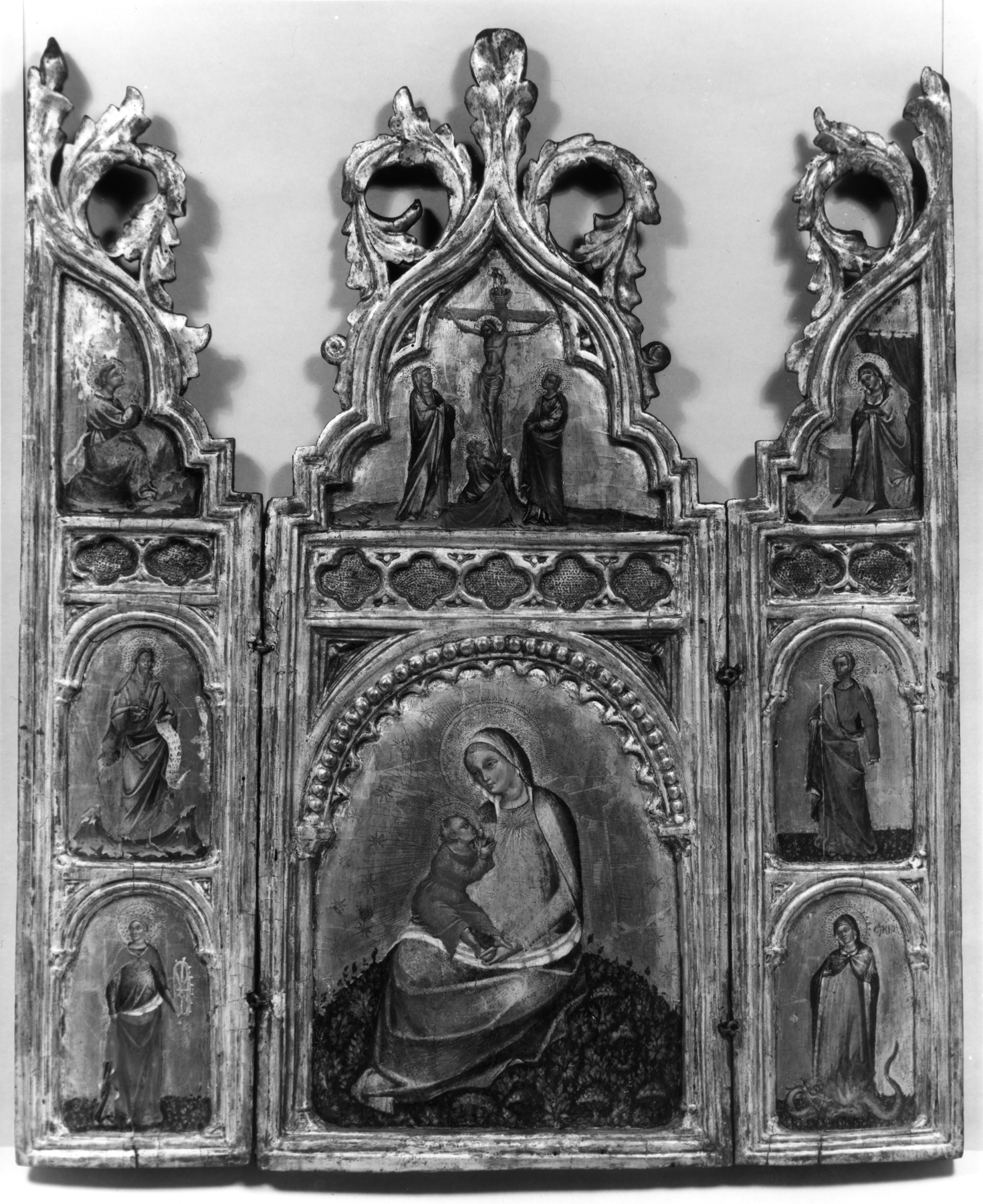Madonna of Humility with Saints
(Medieval Europe )
This folding triptych features Mary and the Christ child at its center, where they share an intimate moment atop a lush, green hillock. Stars, rays, and an elaborate halo have been punched or incised into the gold around the Virgin, creating a holy aura. At the same time, Mary sits on the ground instead of in an elaborate throne, an action which is meant to highlight her compassionate, motherly nature, and her humbleness before God. In these types of depictions, she is known as “Mary of Humility.” As the Christ child nurses and looks up at his mother, she cradles him on her knee and tenderly holds his foot in her hand, though she looks past him with heavy-lidded eyes and downturned lips. Perhaps her somber expression is relates to the small-scale Crucifixion scene at the peak of the triptych, where she stands to the left of her dying son, as Mary Magdalene clutches the cross, and St. John the Evangelist looks on. Atop the cross is a mother pelican that stands in her nest and pierces her own breast in order to feed her starving offspring with her blood. The pelican often served as a symbolic expression of Christ’s suffering for mankind through his Passion and death on the cross. The scene of the Annunciation, Christ’s conception, is split across the Crucifixion in the pinnacles of the triptych’s two wings; the Angel Gabriel kneels on the left, and Mary kneels on the right before a partially drawn curtain. The Annunciation is not only pictured directly beside the Crucifixion, but when the triptych’s panels are closed, the Annunciation scene is completed directly on top of it, visually and symbolically linking the moment of Christ’s conception to his predetermined death. This may suggest the inevitability of his fate weighing on Mary as she nurtures her young child. On the wings of the triptych, four saints set beneath carved arches accompany Mary and her son. On the left, St. John the Baptist is pictured barefoot with a scroll that displays, in Latin, his most well-known proclamation: “Behold, the Lamb of God, that taketh away the sin [of the world].” Below him is St. Catherine of Alexandria, who holds the spiked wheel of her torture. St. James the Great appears on the right wing with his traveling staff, and below is St. Margaret, who stands with a fire-breathing dragon at her feet. The red inscriptions which would have accompanied all the saints are now just barely visible beside St. Margaret and St. James. The remnants of what may have been Gabriel’s salutation are also visible above Mary at the top of the right wing. Many of the saints’ robes, particularly those of St. Catherine and the Virgin, show a faint, though visible residue of a gold pattern, which was added long after the original figures had been painted. The faded star on Mary’s chest is also part of this later addition. While this painting has not been attributed to any specific artist, it seems to bear the stylistic influence of Lorenzo Veneziano and is believed to have been painted in or around Venice.
Inscription
Provenance
Provenance (from the French provenir, 'to come from/forth') is the chronology of the ownership, custody, or location of a historical object. Learn more about provenance at the Walters.
Don Marcello Massarenti Collection, Rome [date and mode of acquisition unknown] [1881 catalogue: no. 184, as Umbrian School, 14th-15th century; 1897 catalogue: no. 58, as Tuscan School, mid 14th century]; Henry Walters, Baltimore, 1902, by purchase; Walters Art Museum, 1931, by bequest.
Exhibitions
| 1962 | The International Style: The Arts in Europe Around 1400. The Walters Art Gallery, Baltimore. |
Geographies
Italy, Venice (Place of Origin)
Measurements
H with original carved and gilded frame: 26 3/8 x W: 21 7/16 x D: 1/2 in. (67 x 54.5 x 1.3 cm); Center panel painted surface H including framing: 26 3/8 x W: 10 13/16 in. (67 x 27.5 cm); Left wing painted surface H including framing: 26 x W: 5 5/16 in. (66 x 13.5 cm); Right wing painted surface H including framing: 25 9/16 x W: 5 5/16 in. (64.9 x 13.5 cm)
Credit Line
Acquired by Henry Walters with the Massarenti Collection, 1902
Location in Museum
Not on view
Accession Number
In libraries, galleries, museums, and archives, an accession number is a unique identifier assigned to each object in the collection.
In libraries, galleries, museums, and archives, an accession number is a unique identifier assigned to each object in the collection.
37.744


